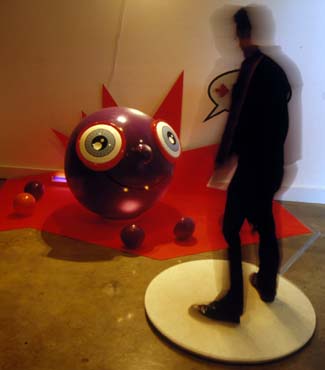Not so innocent gameplay
Dean Kiley

Troy Innocent, Artefact
(OK, so it’s risking an inelegant pun but) Troy Innocent’s work is in fact comprehensively complicit. It’s always been performative and reflexive but this time the dynamics are those of video/computer games and the competing modes of modelling realities with which they’ve memetically infected perception…so you expect, and gloriously get, DIY puzzlers about interactivity, interface, languages, translation and immersion.
Artefact is split—entirely in keeping with its matrix of critical themes—into 2 sections, alternate dimensions with disconcerting shifts of scale. The first, Mixed Reality, is gorgeously uber-kitsch: grouped assemblages of sculptural elements, stylised dioramas made from screen-dumps of an overpopulated video game…the one someone’s playing next door, actually. Built from exuberant glossy-plastic blocks of bright colour, the iconography of Artefact’s second dimension (the game Semiomorph) here emerges lifesize, so you feel you’re in the game. And interactive, with icon-cutout pressure-activated pads on the floor for the viewer to stand on, triggering complexly-patterned light-n-sound-shows around and in the pieces. Each assemblage seems to have its own interface and interactivity protocols, eliciting the classic audience lo-fi paranoia (press here? harder? faster? is it tracking me? are the lights in synch? can I play DJ? why is there a sign warning me not to look at the laser?) and the epistemological dance that accompanies it (no no let ME! See, if you walk through here, then step just…here…and move like this). Hokay, yes, it’s fun, and a bit like a dodgem soundscape, and a bit like an over-ambitious multimedia rave performance, and occasionally a bit like the hypnosis scenes in Exorcist II, but it’s also got Doppler allegorical resonances—about modelling, simulating environments, hyperrealisms, modalities of interaction and the fantastical desire to attribute life/agency/meaning to artificial set-ups—that you take with you when you move into the game itself.
Semiomorph is set up next door in a darkened room with widescreen projection and surround sound, joystick mounted on lectern. The gameplay is as pared back as the virtual environment is densely cluttered: first-person, simplified avatar, routinised navigation, joystick for viewpoint shifts, buttons for movement and firing, collect energy points, elude opposing entities and avoid the randomised blast icons. When you reach a critical mass, or via the intervention of ‘muticons’ or ‘power-ups’, the mode of representation can shift abruptly, transforming the rules of play and relationships between icons and your avatar. At the level of ‘text’ you get viral mutation, when you’re in ‘simulation’ there’s rolling realistic hills, in ‘iconic’ you get chequerboard wire-frame-y constructions and in the ‘diagrammatic’ level you’re faced with a maze. Each level of representation has its own familiar, an icon, tamagotchi-fied and uncannily-cute (eg icon is ‘Specular’, a saucer-eyed anthropomorphised M&M). The environment has no loop-back to a default state, so how the last visitor left it is how you engage with it, disorienting and volatile, algorithmic, promising systematic morphing, logical programming and familiar simulation, but experienced as a series of synthetic disjunctions. As a participatory investigative method for analysing reality modelling—from toys and gaming, through stylised mapping and interactive 3D simulations, among artificial life and virtual realisms, in levels of abstraction and spatialisation, playing with narrative and usability—it’d be difficult to top.
But Innocent does, of course. It comes complete with trading cards (featuring the major avatars of each dimension, listing traits, abilities, “special attacks” and what beats what how), slinky-metallic stickers, impossibly-funky catalogue and essay (pedigree by Darren Tofts out of Andrew Trevillian) and official gameplay instructions with an exoskeleton of compact context. There’s the reminder, for instance, that “Artefact” is a graphics term for errors, those pixellated scruffy bits left over when compressing or translating one file format to another, the unpredictable and ineradicable granular excess that disturbs the smooth artifice of naturalness.
Moreover, Artefact works intermedially within what is perhaps the most consistent, centripetal and rigorously reflexive oeuvre yet produced in Australia that takes as its critical object and creative praxis the phenomenology of digital/new media art, but—yay! yum!—it dramatises what it analyses and critiques. It’s as intriguingly playful as it is heuristic, like a Piccinini installation that’s accidentally incubated an idea.
Perhaps the most fitting comment on the impossibility of perfectible machine translations—between modes of representation, across disparate realities’ media, between the video, computer and other games we play with semiosis, across incommensurate languages—comes from the endearingly ye-olde-world feedback mechanism in one corner of Artefact: the guestbook: “Someone’s eaten too much acid in their lifetime…nice work though.”
Artefact, Troy Innocent, Faculty Gallery, Monash University,
Melbourne, Sept 23 – Nov 3
RealTime issue #46 Dec-Jan 2001 pg. 21






